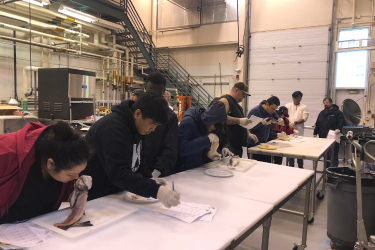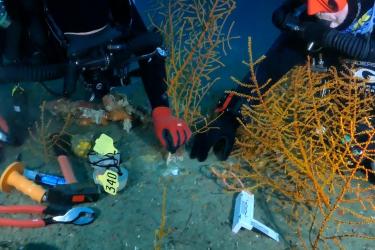A curious conveyor has been at work in the Gulf of Mexico this summer, busily shuttling pieces of vividly colored, fan-like corals to new homes on the deep seafloor.
In shocking colors of orange, purple, and white with long, gently waving branches, these corals have had a remarkable journey to get here. They’re true trailblazers: they represent the first direct outplanting efforts to restore coral communities damaged by the 2010 Deepwater Horizon oil spill in deep areas of the Gulf. They are also part of an effort to better understand the corals themselves—these particular coral species’ biology and mode of reproduction are mostly unknown.
Watch: Corals take a ride on a deep sea elevator
Transplanting fragments of corals onto the seafloor, or “outplanting," is part of a coral propagation project to determine the most effective way to restore deep coral communities damaged in the Gulf of Mexico. These sorts of transplanting tests will help determine whether the technique helps corals grow and reproduce, replacing individuals lost to injury and providing more habitat for fish and invertebrates that rely on corals to survive and thrive.
This past May, nearly 200 fragments of three octocoral species, Thesea nivea, Muricea pendula, and Swiftia exserta—commonly referred to as sea fans—took a ride 230 feet below the surface on a “deep-sea elevator” designed by NOAA’s Southeast Fisheries Science Center for outplanting trials. Testing this at sea was an exciting highlight for the scientists.
Many Hands Make Light Work
The Coral Propagation Technique Development project is part of the Deepwater Horizon restoration program’s Mesophotic and Deep Benthic Communities project portfolio. The project’s numerous partners are one of the keys to its success.
The expedition and science mission, run by NOAA’s National Centers for Coastal Ocean Science, explored and worked in deep water sites with the Beagle, a remotely-operated vehicle (ROV) owned and operated by Marine Applied Research and Exploration. Operators used the Beagle to collect fragments from healthy octocoral colonies and return them to the ship.
Once safely aboard, collaborators from the University of Rhode Island and University at Buffalo affixed the fragments to custom-made racks in temperature controlled environments to prepare them for outplanting at the trial site. Smaller coral samples were also preserved for genetic and reproduction studies.
The outplanting racks were lowered onto the deep-sea elevator, then transferred by ROV to the sea floor. Temperature and current meters were also deployed, and water samples collected to monitor the local environment.
At the end of July, a team of technical divers coordinated by Moody Gardens Aquarium, NOAA, and California Academy of Sciences returned to the outplanting sites to check on the corals. The divers discovered 95 percent of the corals placed in May had survived over the last 2 months and appeared healthy. This is an excellent outcome so far, as the baseline natural survival rate of these octocorals is 92 percent per year.
Improving Octocoral Science
A key element of the coral propagation project has included efforts to fill in knowledge gaps about the growth, feeding, reproduction, and microbiology of these mesophotic species.
Field activities since 2021 successfully located and collected octocorals from the mesophotic zone of the northern Gulf of Mexico for transport to three federal labs. There, aquarists care for, study, and support reproduction studies that are informing restoration efforts in the field as well as improving octocoral knowledge across the science community.
More than 770 square miles of deep-sea and mesophotic (low light) habitats were injured by the 2010 oil spill. The Mesophotic and Deep Benthic Communities at-sea expeditions, which kicked off in 2021, aim to improve understanding and awareness of these poorly explored habitats and restore and protect their unique communities of corals, fish, and invertebrates.





